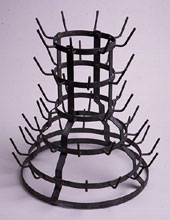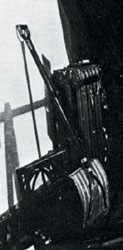Will Go Underground
JEAN NEYENS: Marcel Duchamp, may I ask you where your first works came from, from what reflection upon art at that time or the world at that time?
MARCEL DUCHAMP: It’s very complicated and complex, because, fifty or forty years later, one gets a headache trying to remember how, for what reason, all these things were made and for the most part, when they were created, these things just came pel-mel, without any order. There wasn’t a sort of plan directing all the organization, and, I tell you, it was one thing after another which arrived without any predilection but which pertained to the work preceding it and to the work following it. And for us, forty years later, it all seems to be so homogenous but it’s difficult to explain how it came about.
J. But even if you only reveal to us the significance which you attribute today to your methods of before, that wouldn’t be more false.
MD. Yes, evidently there’s an enormous difference isn’t there… it’s just… the enormous difference is…. I don’t know, the pecuniary order, if you will… When we were making all of that as part of Dada there was never any thought of profiting from it… So it makes an enormous difference, because there wasn’t a plan. We never showed our ongoing works. We didn’t hide them either. Nobody but ourselves, and even among us we spoke of them without attaching any significance to them since that was truly an anti-society position, wasn’t it. So there wasn’t any reason that it would all take some form. And we didn’t think one would ever take.
J. Was this position against society in 1910 already so alive? What was motivating it?
MD. Yes, in 1910, it was less… yet… no… in 1910, there was already the abstract art of Kandinsky, Kupka, Picabia and … Mondrian who were creating only to continue a tradition begun by Courbet, if you will. But the realism of Courbet was then transformed into impressionism, then into fauvism, then into cubism and finally the last incarnation was abstraction, above all with Kandinsky and Kupka and Mondrian.
Then it was necessary to wait for the war in order to arrive at Dada, you see at dadaism which was justly more than a reaction to schematic order or artistic order, even: it was an anti-society reaction as I’ve told you–not even political in the political sense, it wasn’t at all like communism or anything like that, it was an intellectual reaction, a cerebral reaction, almost.
J. Do your ready-mades date from before the war or after the war?
click to enlarge
Figure 1
Marcel Duchamp,
Bottle Dryer,1914
Figure 2
Marcel Duchamp,
Pharmacy,1914
MD. One could say I made one… I created one in 1913, by chance that was before the war. I didn’t call it a ready-made then because I didn’t know what a ready-made was. I hadn’t made… I’d simply made a wheel which turned, a bicycle wheel which turned on a stool, for the pleasure of watching it turn, in my studio as I would have a crackling fire, you see. It was something which–by its movement–was for me… entertaining, you understand, an accompaniment to life, but not at all a work of art in the sense… or even a work of anti-art of any sort. Then I made the Bottlerack.(Fig. 1)
J. The Sechoir à bouteilles.
MD. Le séchoir à bouteilles, which itself wasn’t… which didn’t move. And so you had a movement and an anti-movement. And therefore there was a relation between the two. There were also other things still more interesting in my opinion, there was taking something already made for a model, whcih is what happened withPharmacy, (Fig. 2) you see. It was a small snow-covered landscape made by who knows, that I bought from a shopkeeper, to which I simply added two dots–a red and a green–which indicate the pharmaceutical jars that one sees. All of this made a landscape by sight in the snow you see by adding these two things which could and… would be the lights of a cottage, were in reality… were turned into pharmacy, you see…
Then in 1915 in New York I made a snow shovel that didn’t interest me at all, especially, and so the interesting thing, in all this, wasn’t so much the reaction itself but there was also the idea of finding something in these objects, which wasn’t attractive to the aesthetic point of view. The aesthetic delight was excluded. It’s not comparable to what one calls a “found object” for example. The object found is a thing, it’s a form, in other words a check found on the picket line, or something like that which didn’t interest me, because it was still from the aesthetic domain, by which I mean… a beautiful form, etc. It had already been completely removed from my research.
J. You weren’t trying to dream by exhibiting these new forms, were you?
MD. On the contrary, the interesting thing for me was extracting from its practical domain or its utilitarian domain and bringing it into a domain completely… empty, if you will, empty of everything, empty of everything to a point such that I spoke of a complete anesthesia in order to do it, you understand, which is to say it was necessary… it wasn’t so easy to choose, something which wasn’t pleasing to you and which, you, not pleasing to you, you understand, what I want to say by that… not only what must please you aesthetically but what wouldn’t anymore displease you aesthetically, which is to say the opposite: bad taste instead of good which is the same thing, isn’t it. There isn’t any difference between good and bad taste… two things as little interesting to me as–one or the other, one or the other.
J. So your enterprise was purely against the era. There wasn’t at all, for example… ambition… to teach the eye to admire or to…
MD. the eye…
J. … or to adapt itself, let’s say, to new forms in a spirit a little functionalistic.
MD. No, not at all, not at all, not at all. And it’s because of this that all these ready-mades, in sum, are so different from one another… so different that there isn’t, if you will.. the air of a family about them… there isn’t any air of family between Pharmacy, which we’ve spoken of, and the Bottlerack or the Bicycle Wheel that turns! Obviously we say “manufactured object.” But it’s not always about manufactured objects. I even once made to amuse myself… in a restaurant, I was dining with some friends in New York, there was a big decorative painting, which decorated this restaurant, and which was completely ridiculous, just like a painting, from every point of view, and I stood up, then I signed it, you understand. It is therefore… it’s still there… this readymade wasn’t manufactured, it was made by hand even if by another painter! And what’s more, in one of my works, I put a hand which indicates, you see, the management one uses in public establishments. I put this hand there but I myself hadn’t painted it. I had it painted by a painter of signs.
J. Nevertheless in the act of naming… an earthenware public urinal…
MD. … yes, yes, yes…
J. … a fountain…
MD. …yes, yes…
J. … it’s the same as…
click to enlarge
Figure 3
Marcel Duchamp,
Fountain, 1917
(Photograph by
Alfred Stieglitz)
Figure 4
Marcel Duchamp, In
Advance of a Broken
Arm, 1915
(Studio photograph)
MD. … a urinal, that I named Fountain (Fig. 3) in order to disengage it from its utilitarian purpose! The idea of a fountain…
J. …yes…
MD. …was completely ironic, since there wasn’t even a fountain there, but then this support, and then still the title wasn’t absolutely necessary, although I often used to add a phrase… for example with the Bottlerack I had bought… added a phrase that I don’t remember because the Bottlerack is lost, was lost in 1916, something like that–during a move–and I’d written a subtitle to it and I absolutely can’t remember it, not a thing, not even a word.
But with the snow shovel, I wrote “In advance of a broken arm”(Fig. 4) trying also to find a phrase which wanted to say nothing. Because even if this could want to say something… the advance of the arm, “in advance of a broken arm” has a truly useless meaning, you understand, and without great interest!
J. There wasn’t any intention there of farce?
MD. Not at all, not at all! No, the farce was… for me, it was me who… even more, there wasn’t a farce there since nobody was taking an interest in it! There wasn’t a public there, there wasn’t… it wasn’t presented to the public. There wasn’t participation at all from the public or acceptance from the public or even calling upon the public as witness and asking what the public thought of it, you understand… it was different outside, even so, I tell you, the ensemble of all these things was in a climate where the public wasn’t invited! There wasn’t any public–the public wasn’t invited, wasn’t necessary… at all!
J. You’re not at all a professional painter?
MD. That’s what I’ve always wanted to escape, being professional in the sense of being obligated to live from painting, which produces a little bit but… it’s unconfirmed once done… and above all you know what happens when the art dealers say to you, “Ah! If you make ten pictures for me in this style, I will sell as many as you want of them.” Then–well this wasn’t at all my interest or my amusement, soI didn’t do it. I made nothing. Then it was like this, I went to a conference. A round table which took place in Philadelphia, where I was asked, “Where are we going?” Me, I simply said, “The great fortune of tomorrow will hide itself. Will go underground.” In English it’s better than in French–“Will go underground.” It’ll be necessary that it dies before being known. Me, in my opinion, if there is an important fellow from now in a century or two–well! he will have hidden himself all his life in order to escape the influence of the market… completely mercenary [laughs] if I dare say.
Figs. 1-4
©2002 Succession Marcel Duchamp, ARS, N.Y./ADAGP, Paris. All rights reserved.